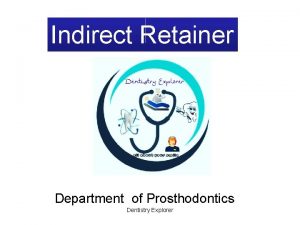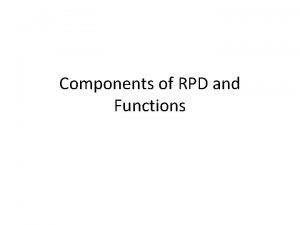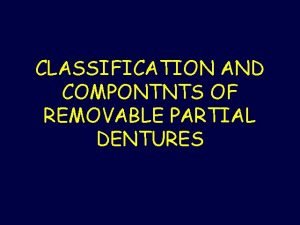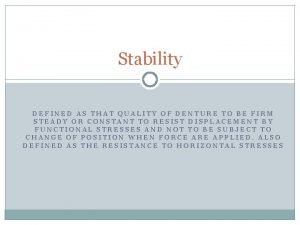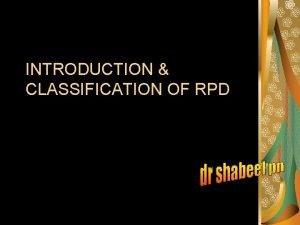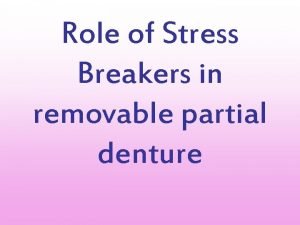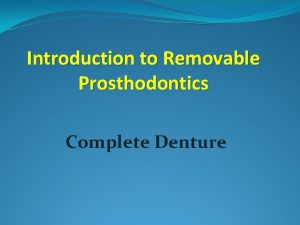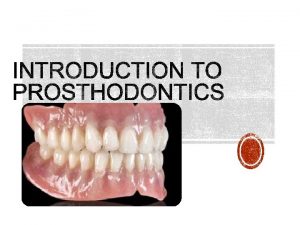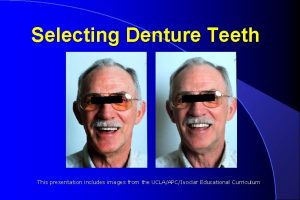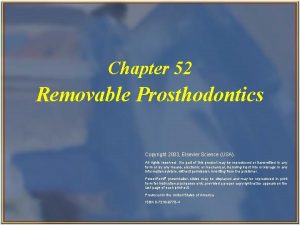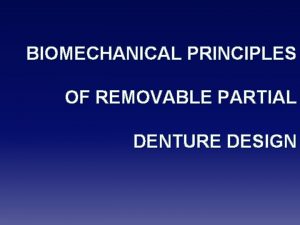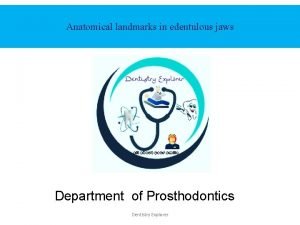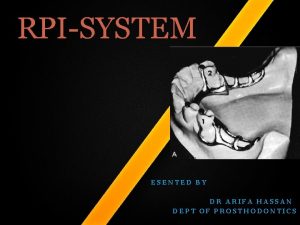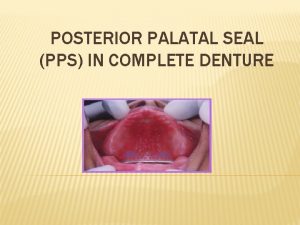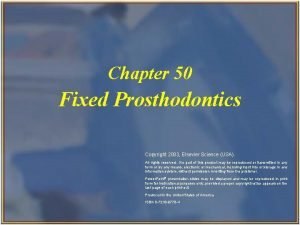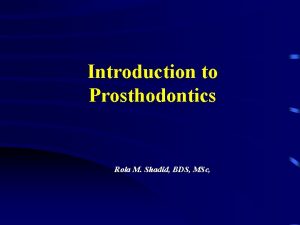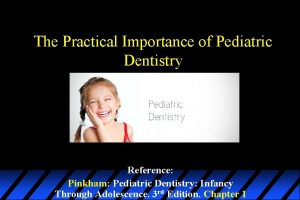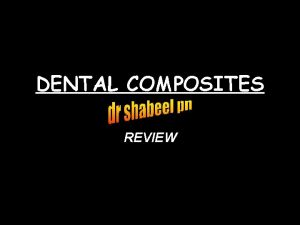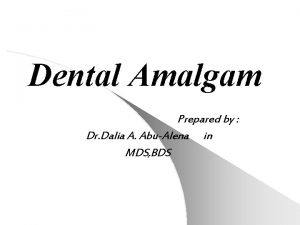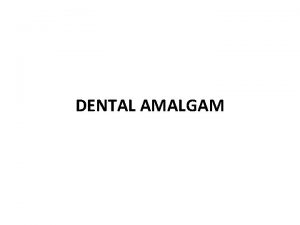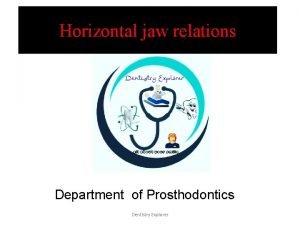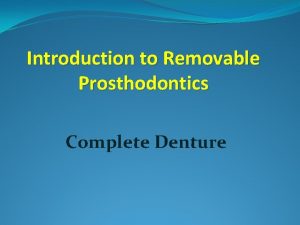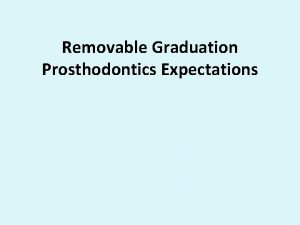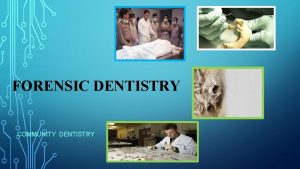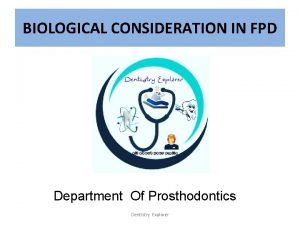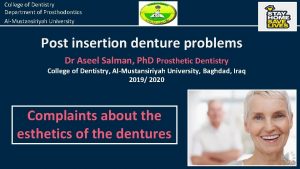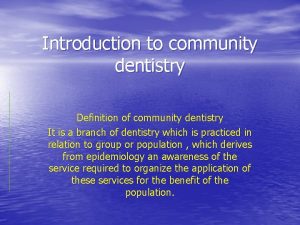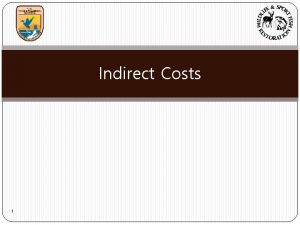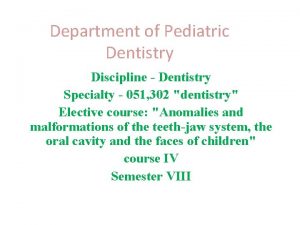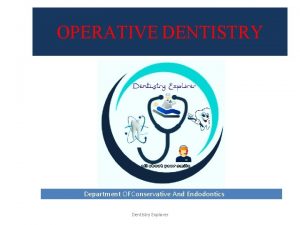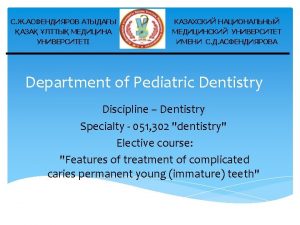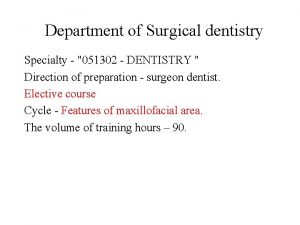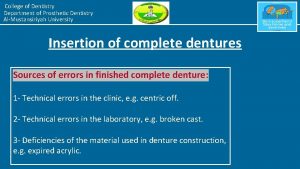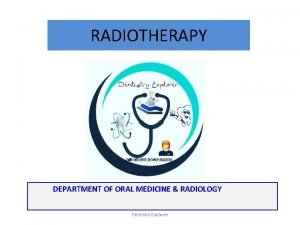Indirect Retainer Department of Prosthodontics Dentistry Explorer Definition



































- Slides: 35

Indirect Retainer Department of Prosthodontics Dentistry Explorer

Definition: “The component of a removable partial denture that assists the direct retainer (s) in preventing displacement of the distal extension denture base by functioning through lever action on the side opposite of the fulcrum line when the denture base moves away from the tissues in pure rotation around the fulcrum line. ” - Glossary of Prosthodontic Terms (8 th ed). Dentistry Explorer

FULCRUM LINES: FULCRUM LINE AXIS : An imaginary line, connecting the most distal occlusal rests, around which a removable partial denture tends to rotate TOWARDS the tissue under masticatory forces. RETENTIVE FULCRUM LINE AXIS : An imaginary line connecting the retentive clasp tips around which movement of the base AWAY from the ridge occurs. (This is the axis relevant to indirect retention. ). Dentistry Explorer

Cantilever ? ? Effort (Lifting Force of sticky food. ) Fulcrum (Direct retainer) Dentistry Explorer

Cantilever Lifting force of sticky food With direct retainer at fulcrum, lifting force will depress one end of the beam and elevate the other end. Dentistry Explorer

Lever ? ? Dentistry Explorer

Which class lever ? ? Lifting force of sticky food Dentistry Explorer

Primary Function of Indirect retainer: It shifts the fulcrum away from the point of application of the force, there by counteracting the lifting force and stabilizing the denture. Lever: Cantilever: A saddle which is cantilevered out from the direct retainer (s) A lever system is created by the use of indirect retainer to keep the saddle in place. Dentistry Explorer

NOTE: - “Indirect retainer does not prevent the tissue-ward movement of the free-end saddle”. The indirect retainer moves occlusally. Masticatory force Dentistry Explorer

Placement of indirect retainers: 1. It must be placed in rest seats that transmit applied forces through the long axis of the tooth. 2. It is located on the opposite side of the retentive fulcrum line from the denture base (saddle). 3. It should be placed as far as possible from the retentive fulcrum line. Dentistry Explorer

5. Ideally Indirect retainer should be located at a point perpendicular to the midpoint of the fulcrum line. Dentistry Explorer

6. Most effective location for Indirect retainer in Kennedys class I RPD is incisor region , but due to their poor strength canines or premolars are used. 7. Whenever possible two IRs , closer to fulcrum line are taken to compensate for the compromise in distance. Dentistry Explorer

The factors influencing the effectiveness of an indirect retainer: 1. Proper seating of the denture i. e; proper functioning of direct retainers. 2. Distance from the fulcrum line. 3. The rigidity of the connectors supporting the indirect retainer. All connectors must be rigid if the indirect retainer is to function as intended. 4. The effectiveness of the supporting tooth surface. The indirect retainer must be placed on a definite rest seat, , on which slippage or tooth movement will not occur. Tooth inclines and weak teeth should never be used for the support of indirect retainers. Dentistry Explorer

Examples of RPD designs which include indirect retention: - I. Kennedy I: Indirect retention in this design is provided by incisal rests. Dentistry Explorer

II. Kennedy II: Indirect retention in this instance is provided primarily by rests on 44 and 43 as they are farthest from the clasp axis. Dentistry Explorer

III. Kennedy III: When only one of the abutments is suitable for clasping (e. g ; for aesthetic reasons) an indirect retention can be used. Dentistry Explorer

IV. Kennedy IV: Indirect retention has been achieved by placing the rests on 17 and 27 as far posteriorly as possible. Dentistry Explorer

Forms of the indirect retainer: 1. Lingual Rest Seats: a. Cingulum Rest Seat Form b. Composite Bonded Rest Seat Form c. Round Lingual Rest Seat Form 2. Incisal Rests: 3. Occlusal Rest Seats: Dentistry Explorer

1. Lingual Rest Seats: Auxiliary cingulum rests: - ØThe cuspid is the most easily utilized anterior tooth for preparation of a rest seat since the cingulum is usually more prominent than the lateral or central incisors. ØThe cingulum rest seat should be prepared in the bulk of the cingulum to minimize tooth reduction. ØThe cavosurface should be less than 90° to prevent orthodontic movements of the tooth. Dentistry Explorer

Preparation Too High Preparation Too Low Dentistry Explorer

Correct Incorrect Dentistry Explorer

Factors to be considered prior to the preparation of a cingulum rest seat: 1. The prominence and shape of the natural cingulum. Ø Cingulum rest seats must be placed in sound tooth structure. Ø Where the cingulum is not prominent or when preparation might encroach upon the pulp, other means of securing a lingual rest seat must be considered (i. e. selection of a different tooth, use of a composite bonded rest seat, onlay, crown etc. ) Dentistry Explorer

Composite Buildups for Cingulum Rests: When a cingulum is poorly developed, with insufficient bulk for preparation for a cingulum rest seat, a rest seat can be made using composite resin. Dentistry Explorer

Round Lingual Rest Seat Form Round rest seats are occasionally prepared on the mesial of the canine teeth when the use of a typical cingulum rest is contraindicated (i. e. large restoration, lack of clearance with the opposing teeth, poorly developed cingulum). Dentistry Explorer

2. The interocclusal relationship. When a deep vertical overlap exists, care must be taken to ensure that the mandibular tooth does not prematurely contact the area of the planned metal framework. Incorrect Correct Dentistry Explorer

If a rest is placed on an unprepared cingulum Dentistry Explorer

2. Incisal Rests: Inferior to lingual rests both mechanically and esthetically. Normally they should not be used unless it is impossible to place a lingual rest seat or a composite bonded rest seat. a. It is usually placed on the mesio- or disto-incisal angle of the incisor teeth with the deepest portion towards the centre of the tooth. b. It is usually used on the mandibular incisor where the lower lip can cover, as much as possible, the metal of the rest that shows at the incisal edge. Mechanically, a lingual rest is preferable to an incisal rest, because the lingual rest is placed nearer to the center of rotation of the tooth and therefore, will have less tendency to tip the tooth. Dentistry Explorer

Incisal Rests Dentistry Explorer

3. Auxiliary occlusal rest: Usually placed on the mesio-occlusal of a first bicuspid tooth when their is inadequate cingulum tooth structure on the canines or there is poor access to the lingual surfaces of the anterior teeth. (a) The outline of an occlusal rest seat is a rounded triangular shape with its apex nearest to the centre of the tooth. (b) The base of the triangular shape is at the marginal ridge and should be approximately one third the bucco-lingual width of the tooth. Dentistry Explorer

(c) The marginal ridge must be lowered and rounded to permit a sufficient bulk of metal to prevent fracture of the rest from the minor connector (1 to 1. 5 mm) Dentistry Explorer

(d) The floor of the rest seat should be inclined towards the centre of the tooth, so that the angle formed by the rest and the minor connector should be less than 90°. This helps to direct the occlusal forces along the long axis of the tooth. Dentistry Explorer

(e) The floor of the rest seat should be concave or spoon shaped to create a ball-and-socket type of joint. This will prevent horizontal stresses and torque on the abutment tooth. When occlusal rest seats are prepared next to an edentulous space the morphology follows conventional form. Dentistry Explorer

When a single occlusal rest seat is prepared next to an adjacent tooth the form is modified. The rest seat is not flared to the facial line angle. Instead, the lingual line angle is flared more dramatically to provide additional space for the minor connector. Dentistry Explorer

When embrasure occlusal rest seats are prepared on adjacent teeth, the form is modified. Additional tooth structure is removed in the marginal areas to provide at least 1. 5 mm of room for the embrasure clasps. The rest seats are flared more dramatically to the facial and the lingual line angles. Dentistry Explorer

Dentistry Explorer
 Indirect retainer
Indirect retainer Fulcrum line in class 3
Fulcrum line in class 3 Auxiliary rest in rpd
Auxiliary rest in rpd Lingual plate rpd
Lingual plate rpd Indirect retainer
Indirect retainer Cast circumferential clasp
Cast circumferential clasp Indirect retainer in class 1
Indirect retainer in class 1 Tissue borne rpd
Tissue borne rpd Stability denture
Stability denture Atmospheric pressure in complete denture
Atmospheric pressure in complete denture Prosthodontics definition
Prosthodontics definition Quadrilateral configuration rpd
Quadrilateral configuration rpd Steps in cd fabrication
Steps in cd fabrication Prosthodontics definition gpt
Prosthodontics definition gpt Portrait denture teeth
Portrait denture teeth Chapter 52 removable prosthodontics
Chapter 52 removable prosthodontics Quadrilateral clasp configuration
Quadrilateral clasp configuration Fully bilateral balanced occlusion
Fully bilateral balanced occlusion Buccal shelf definition
Buccal shelf definition I bar clasp system
I bar clasp system Branches of prosthodontics
Branches of prosthodontics Function of pps
Function of pps Dental ring clasp
Dental ring clasp House classification of patient
House classification of patient Fixed prosthodontics chapter 50
Fixed prosthodontics chapter 50 Haemodent
Haemodent Introduction to prosthodontics
Introduction to prosthodontics Principle of tooth preparation
Principle of tooth preparation Pinkham pediatric dentistry
Pinkham pediatric dentistry Gingival bevel in class 2 inlay
Gingival bevel in class 2 inlay Composite chemistry definition
Composite chemistry definition High copper alloy
High copper alloy Spherical dental definition
Spherical dental definition What is forensic odontology definition
What is forensic odontology definition Biomedical concept of health
Biomedical concept of health Paul revere forensic dentistry
Paul revere forensic dentistry
